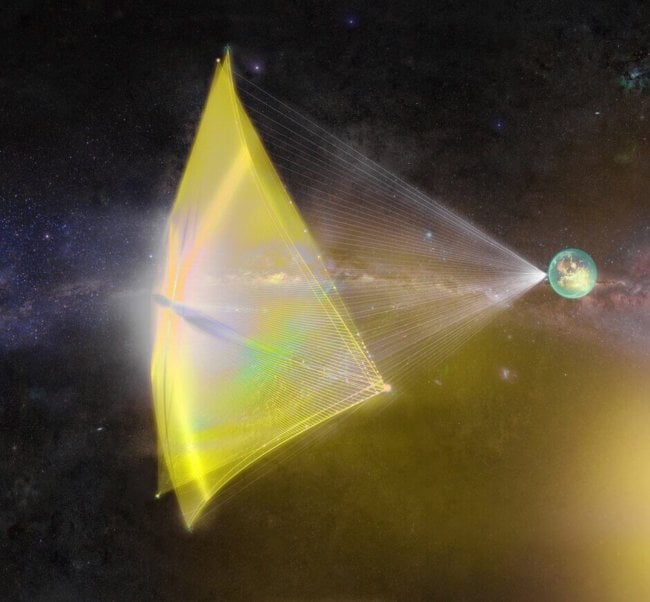
Once humanity had the ambition that led to such incredible projects as the first manned flight into space or a mission to the moon. The next step will be colonization of planets, and then interstellar travel. Initiative Breakthrough Starshot becomes the successor to the human ambitions and promises to pave the way for us to the nearest stars.
Breakthrough Starshot, the brainchild of Russian entrepreneur and billionaire Yuri Milner, became known in April 2016 at a press conference, in which participated well-known physicists, including Stephen Hawking and Freeman Dyson. Although the project is not quite complete, a preliminary plan involves sending a thousand chips the size of a postage stamp on a large silver sails, which first released on the earth’s orbit, and then will be accelerated by ground lasers.
Two minutes of laser acceleration the spacecraft will accelerate up to one-fifth the speed of light — a thousand times faster than any artificial device in the history of mankind.
Each unit will fly 20 years and collect scientific data on interstellar space. Reaching the planets in the star system of alpha Centauri, built-in digital camera will be photographed in high resolution and send them to the Earth, allowing us to look at our closest planetary neighbors. In addition to scientific knowledge we can tell if these planets for colonization of the human.
The team, which is Starshot Breakthrough, as impressive as the technology. The Board of Directors consists Milner, Hawking and mark Zuckerberg, Creator of Facebook. The role of the Executive Director Pete worden, former Director of the research center at NASA Ames. Several well-known scientists, including Nobel laureates, to advise the project, and Milner put 100 million dollars of his own money to start the work. Together with colleagues they invest more than $ 10 billion within a few years, so the work was completed.

Although this whole thing seems completely sci-Fi, there is no scientific obstacles to its implementation. This, however, does not necessarily have to happen tomorrow: to Starshot was successful, the necessary number of achievements in the field of technology. Organizers, scientists and consultants believe in exponential progress and that Starshot implemented within 20 years.
Then you will find a list of eleven technologies Starshot and any hope for their exponential development during the next twenty years, lay scientists.
The detection of exoplanets
Exoplanet is a planet outside our Solar system. Although the first scientific discovery of exoplanets was held only in 1988, on may 1, 2017 was discovered 3608 2702 exoplanets in planetary systems. Although some of them resemble planets in the Solar system, among them there are many unusual, for example, with rings 200 times wider than Saturn’s rings.
The reason for this flood of discoveries? A substantial improvement of telescopes.
Just 100 years ago, the largest telescope in the world was the hooker telescope with a mirror of 2.54 meters. Today the Very Large Telescope of the European southern Observatory consists of four large telescopes with a diameter of 8.2 meters and is the most productive ground-based astronomical installation, outstanding one scientific paper on a peer review day.
Scientists use MBT and a special tool to search for a solid extrasolar planets in the potentially habitable zone of a star. In may 2016, scientists using the TRAPPIST telescope in Chile, found not one, but seven exoplanets of earth size potentially habitable zone.
Meanwhile in space, the spacecraft NASA Kepler, specifically designed for this task have already identified more than 2000 exoplanets. Space telescope James Webb, which will be launched in October 2018, will provide unprecedented insight whether exoplanets are to support life. “If these planets have an atmosphere, JWST will be the key to unlocking their secrets,” says Doug Hudgins, exoplanet program scientist at headquarters NASA in Washington.
Start costs

Mothership Starshot will be launched aboard the rocket and release a thousand ships. The cost of transporting the payload with the use of disposable rockets are huge, but private service providers such as SpaceX and Blue Origin, demonstrated success in launching reusable rockets, which is expected to significantly reduce the cost of launch. SpaceX has already reduced the cost to $ 60 million for a Falcon 9 launch, and as the expanding private space industry and reusable rockets become more common, the price will fall and fall.
Starchip
Each 15-mm Starchip (“star chip”) must contain a large array of ingenious electronic devices such as navigation system, camera, laser communications, radioisotope battery, the multiplexer of the camera and its interface. Engineers hope to be able to shrink it all in a small device the size of a postage stamp.
In the end, the first computer chips in the 1960-ies contained a handful of transistors. Thanks to Moore’s law, today we can fit billions of transistors on each chip. The first digital camera weighed several pounds and made of 0.01-megapixel image. Today the digital camera’s sensor makes high-quality color images at 12 megapixels and fits in a smartphone — along with other sensors like GPS, accelerometer and gyroscope. And we see these improvements seep into space exploration with the advent of small satellites, providing us with quality data.
For success Starshot we need the mass of the chip was approximately 0.22 grams by 2030. But if the improvements will keep coming at the same rate, projections suggest that it is quite possible.
Easy sail
The sail must be made of material that will have a high reflectivity (to get maximum momentum from the laser), the minimum absorbent (not burned from the heat) and it is very easy (to quickly accelerate). These three criteria are extremely important, and at present suitable material for them simply does not exist.
Needed achieve can come from automation to artificial intelligence and accelerate discovery of new materials. This automation has reached the point that machine learning methods today that can “generate a library of candidates for suitable materials to tens of thousands of items” and allow engineers to determine what is worth fighting for and what is necessary to test under certain conditions.

Energy storage
Although Starchip will use a tiny radioisotope battery during his 24-year journey, we will still need a conventional chemical battery for lasers. Lasers need to release enormous energy in a short time, and hence energy to be stored in batteries nearby.
The battery are improved by about 5-8% per year, although we often don’t see it, because the level of energy consumption is increasing. If batteries continue to improve at this rate, in twenty years they will be 3-5 times more capacity than today. Other innovations may follow a major investment in batteries. A joint venture with Tesla and Solar City have already put 55,000 in Kauai to power much of its infrastructure.
Lasers
Thousands of powerful lasers will be used to advance the apparatus along with the sail.
Lasers obey Moore’s law almost the same as the integrated circuit, multiplying the capacity by half every 18 months. Over the last decade there has been a sharp acceleration scaling power diode and fiber lasers. The first struck 10 kilowatts of single mode fiber in 2010 and the 100 kW barrier a few months. In addition to the raw power we need to have success in combining a matrix phased array of lasers.
Speed
Our ability to move fast… move fast. In 1804 was invented the train and very soon scored an unheard of speed of 100 kilometers per hour. Spacecraft “Helios-2” have eclipsed this record in 1976: fastest time “Helios-2” was removed from the Earth at speeds of 356 040 km/h. After 40 years, the spacecraft “New horizons” reached a heliocentric speed of 45 kilometers per second (over 200,000 miles per hour). But even if to move with the same speed it will take a long time to reach alpha Centauri four light years from us.
Although the acceleration of subatomic particles to relativistic speeds has become commonplace in particle accelerators, macroscopic objects to disperse did not work. Achieving 20% the speed of light will be a 1000-fold increase in speed for any object built by man.
Memory storage
The basis for the calculations was the ability to store information. Starshot will depend on continuing to reduce the cost and size of digital memory to provide sufficient storage space for their programs and images made in the star system of alpha Centauri and its planets.
The cost of memory has decreased exponentially for decades: in 1970, a megabyte is about one million dollars; now a mere penny. The size required for storage, also shrank from 5-needs hard drive, downloadable in 1956 with the help of a forklift truck, up to 512 GB USB flash drives weighing a few grams.
Telecommunications
Once Starchip take pictures, they will need to send back for processing.
Telecommunications have progressed significantly since Alexander Graham bell invented the telephone in 1876. The average Internet speed today is about 11 megabits per second. The bandwidth and speed required to send digital images over 4 light years away — 40 trillion kilometres — will require the latest advances in the field of telecommunications.
Very promising is the technology Li-Fi, wireless transfer which promises to be 100 times faster Wi-Fi. Also experiments in the field of quantum telecommunications, which will not be fast, but safe.
Calculations
The last step of the project Starchip will be the analysis of the data returned by the spacecraft. For this we have to rely on the exponential development of computing power that has increased a trillion times over the last 60 years.
Reducing the cost of computing a lot lately associated with clouds. Looking to the future and using new techniques like quantum computing, we can expect a thousandfold increase in power by the time when Starshot will return data. This exceptional computing power will allow us to perform complex scientific modeling and analysis our nearest neighboring star system.
Interstellar travel will be possible sooner than you think
Ilya Hel